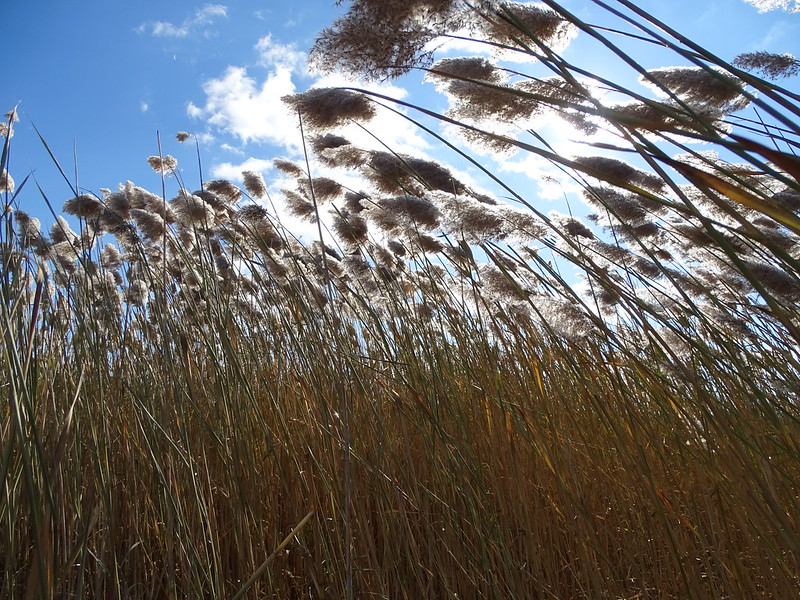
To protect Minnesota’s wetlands, shorelines, and native Phragmites from invasive European Phragmites, it is important to understand whether hybridization between native and non-native genotypes is occurring. Our finding that hybrids appear to be present in the state underscores the importance of a proactive, landscape-level response to Phragmites invasion.
Recently completed MAISRC-funded research has documented the distribution of invasive (European-origin) populations of the wetland grass Phragmites australis (common reed) in Minnesota. We now know that invasive Phragmites is widespread throughout the state and commonly occurs in close proximity to the native subspecies (P. australis ssp. americanus). This sympatry suggests the potential for pollen exchange that could lead to emergence of intraspecific hybrid populations in Minnesota. Indeed, that Phragmites can hybridize has been documented through greenhouse experiments and identification of wild hybrids over the past 10 years. However, hybrid Phragmites has been considered rare and reports have been consistent with hybrids exhibiting characteristics that are intermediate between parental species, as opposed to the invasion-accelerating “hybrid vigor” observed in crosses between invasive and native lineages in other wetland plant species, e.g. Typha (cattails) and Spartina (cordgrass). This has led to a general perception of there being low risk associated with hybridization in Phragmites.
A new study suggests that such low perception of risk may be misguided. Williams et al. (2019) contrasted hybrid Phragmites with parental lineages in an invasion complex in Las Vegas, finding that hybrid populations exhibited characteristics associated with increased invasion risk (higher aboveground biomass, reproductive capacity, and genetic diversity). This evidence of hybrid vigor in Phragmites is particularly concerning in Minnesota, where there is high sympatry (co-occurrence) between parental lineages. Furthermore, it may be that Phragmites hybridization has been systematically underestimated due to subtle phenotypic differences, past research being concentrated in areas with little remaining native Phragmites, and/or use of relatively insensitive molecular methods for detecting hybrids.
Samples, data, and methods generated by recently completed and ongoing molecular genetic research. Tools to distinguish native from exotic reed canarygrass; Invasive potential and control of Minnesota knotweed) affords us a unique opportunity to rapidly and cost-effectively identify hybrids and assess risk. This project will develop a new method for detecting Phragmites hybrids by leveraging (1) genomic approaches developed for reed canary grass and invasive knotweeds and (2) native and invasive Phragmites samples already collected throughout the state and analyzed using microsatellite markers. Additionally, researchers have already acquired confirmed hybrid samples from the Williams et al. (2019) study for use in methods development. This project will result in optimization of the methodologies and their application to our archived samples from Phragmites populations throughout Minnesota. These include samples of special interest due to close sympatry of native and invasive Phragmites and cases of putatively native Phragmites (per microsatellites) that is phenotypically similar to invasive Phragmites (unusually tall and robust).
Findings
Recent evidence of hybrid vigor in crosses between native and invasive Phragmites australis (common reed) is concerning for Minnesota, where both subspecies are widespread and overlapping. Furthermore, it may be that Phragmites hybridization, which is considered rare, has been underestimated due to limitations in where hybrids have been searched for and the molecular methods that have been used. Our primary objectives were to develop—and apply to Minnesota Phragmites samples—a new method for detecting Phragmites hybrids by leveraging (1) genomic approaches developed for other plants species and (2) native and invasive Phragmites samples already collected throughout the state through subproject 17. The project was implemented by extracting DNA from Phragmites leaf samples and submitting it for DArTseqLD analysis (for identification of single nucleotide polymorphisms [SNP]) by Diversity Arrays Technologies (Bruce, ACT, Australia). Bioinformatics and population genetic analyses were applied to the SNP data to identify possible hybrid genotypes. SNP data were derived from 286 Phragmites samples. Of these, 3.8-6.6% of samples (depending on statistical method) were identified as putative hybrids. Possible hybrids were concentrated in the Metro region and southern Minnesota but found throughout the state. These findings have important implications for efforts that are underway to treat invasive Phragmites populations across the state. Emergence of hybrids underscores the urgency of eliminating invasive populations as quickly as possible.
